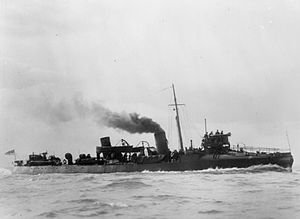HMS Decoy (1894)
 Decoy
| |
| History | |
|---|---|
| Name | Decoy |
| Builder | John I. Thornycroft & Company, Chiswick |
| Cost | c.£36,000 |
| Yard number | 288 |
| Laid down | July 1892 |
| Launched | 7 February 1894 |
| Completed | June 1895 |
| Fate | Sunk in collision, 13 August 1904 |
| General characteristics [1] | |
| Class and type | Daring-class torpedo boat destroyer |
| Displacement |
|
| Length | 185 ft (56 m) oa |
| Beam | 19 ft (5.8 m) |
| Draught | 7 ft (2.1 m) |
| Installed power | 4,200 hp (3,100 kW) |
| Propulsion |
|
| Speed | 27 kn (31 mph; 50 km/h) |
| Crew | 46-53 |
| Armament |
|
HMS Decoy was a Daring-class torpedo boat destroyer which served with the Royal Navy in home waters. She was launched in 1895 and sunk in a collision with the destroyer HMS Arun in 1904.
Construction[edit]
She was built by John I. Thornycroft & Company at Chiswick and was launched on 7 February 1894.[2]
Although fitted with multiple torpedo tubes, her bow tube proved useless in practice as — while running at high attack speeds — the ship was prone to overtake its own torpedo. The clumsy tube also reduced living quarters and made the bridge very prone to flooding.
Service[edit]
Decoy took part in the 1896 British Naval Manoeuvres, attached to the Channel Fleet operation from Berehaven in southern Ireland.[3] She served as instructional tender to Cambridge, a gunnery school ship, until August 1901.[4] Lieutenant Cyril Asser was appointed in command in February 1902, when she was based at Plymouth as part of the Devonport instructional flotilla,[5] and was succeeded by Lieutenant Henry Ralph Heathcote on 1 July the same year.[6] Heathcote transferred to Contest the following month, and was succeeded in command by Lieutenant L. J. I. Hammond on 8 August 1902.[7] She took part in the fleet review held at Spithead on 16 August 1902 for the coronation of King Edward VII.[8] She acted temporary as tender to Cambridge again from late August, when her crew transferred to HMS Ostrich, which took her place in the flotilla.[9] The following month she was reported to be back in the instructional flotilla.[10]
Decoy was lost in a collision with the destroyer Arun off the Scilly Islands on 13 August 1904.[11] while taking part in night exercises.[12] One man was killed while the remaining 40 members of the crew were rescued by Arun and Sturgeon.[12] Courts martial regarding the sinking were subsequently assembled aboard the battleship Conqueror. The first, on 22 August,[13] attributed blame to the commander of Arun, Reginald Tyrwhitt. The second, an appeal, was held on 30 August,[14] and dismissed the charge of neglect but confirmed the charge of hazarding both vessels.
Notes[edit]
- ^ British "18-inch torpedoes" were 450mm (17.72 inches) in diameter.
References[edit]
- ^ Lyon (1996), pp.40-41.
- ^ The Times (London), Thursday, 8 February 1894, p.4
- ^ Brassey (1897), pp. 141–143, 149.
- ^ "Naval & Military intelligence". The Times. No. 36535. London. 16 August 1901. p. 6.
- ^ "Naval & Military intelligence". The Times. No. 36696. London. 20 February 1902. p. 10.
- ^ "Naval & Military intelligence". The Times. No. 36790. London. 10 June 1902. p. 12.
- ^ "Naval & Military intelligence". The Times. No. 36839. London. 6 August 1902. p. 8.
- ^ "Naval Review at Spithead". The Times. No. 36847. London. 15 August 1902. p. 5.
- ^ "Naval & Military intelligence". The Times. No. 36845. London. 13 August 1902. p. 8.
- ^ "Naval & Military intelligence". The Times. No. 36883. London. 26 September 1902. p. 8.
- ^ The Times (London), Wednesday, 15 August 1904, p.5
- ^ a b Kemp (1999), p. 1.
- ^ The Times (London), Thursday, 23 August 1904, p.9
- ^ The Times (London), Friday, 31 August 1904, p.4
Bibliography[edit]
- Brassey, T.A. (1897). The Naval Annual 1897. Portsmouth, UK: J. Griffin and Co.
- Chesneau, Roger & Kolesnik, Eugene M., eds. (1979). Conway's All The World's Fighting Ships 1860–1905. London: Conway Maritime Press. ISBN 0-85177-133-5.
- Colledge, J. J.; Warlow, Ben (2006) [1969]. Ships of the Royal Navy: The Complete Record of all Fighting Ships of the Royal Navy (Rev. ed.). London: Chatham Publishing. ISBN 978-1-86176-281-8.
- Dittmar, F. J.; Colledge, J. J. (1972). British Warships 1914–1919. Shepperton, UK: Ian Allan. ISBN 0-7110-0380-7.
- Friedman, Norman (2009). British Destroyers: From Earliest Days to the Second World War. Barnsley, UK: Seaforth Publishing. ISBN 978-1-84832-049-9.
- Kemp, Paul (1999). The Admiralty Regrets: British Warship Losses of the 20th Century. Sutton Publishing Ltd. ISBN 0-7509-1567-6.
- Lyon, David (2001) [1996]. The First Destroyers. London: Caxton Editions. ISBN 1-84067-364-8.
- Manning, Thomas Davys, Captain (1961). The British Destroyer. Putnam & Co. OCLC 6470051.
{{cite book}}: CS1 maint: multiple names: authors list (link) - March, Edgar J. (1966). British Destroyers: A History of Development, 1892–1953; Drawn by Admiralty Permission From Official Records & Returns, Ships' Covers & Building Plans. London: Seeley Service. OCLC 164893555.
